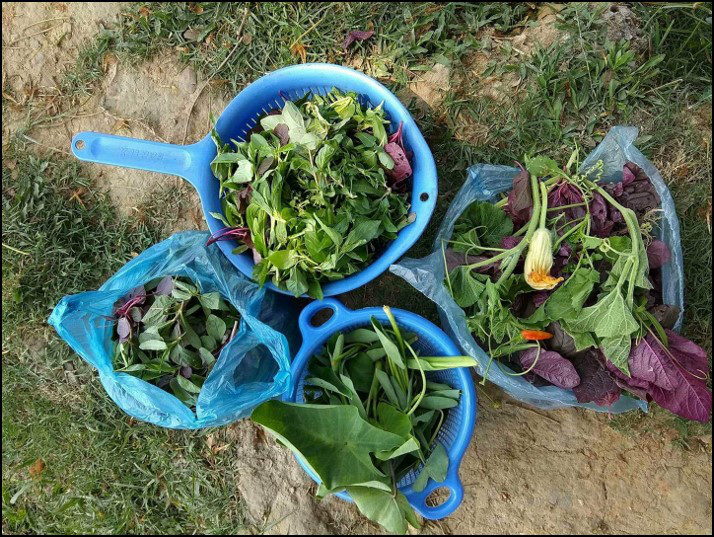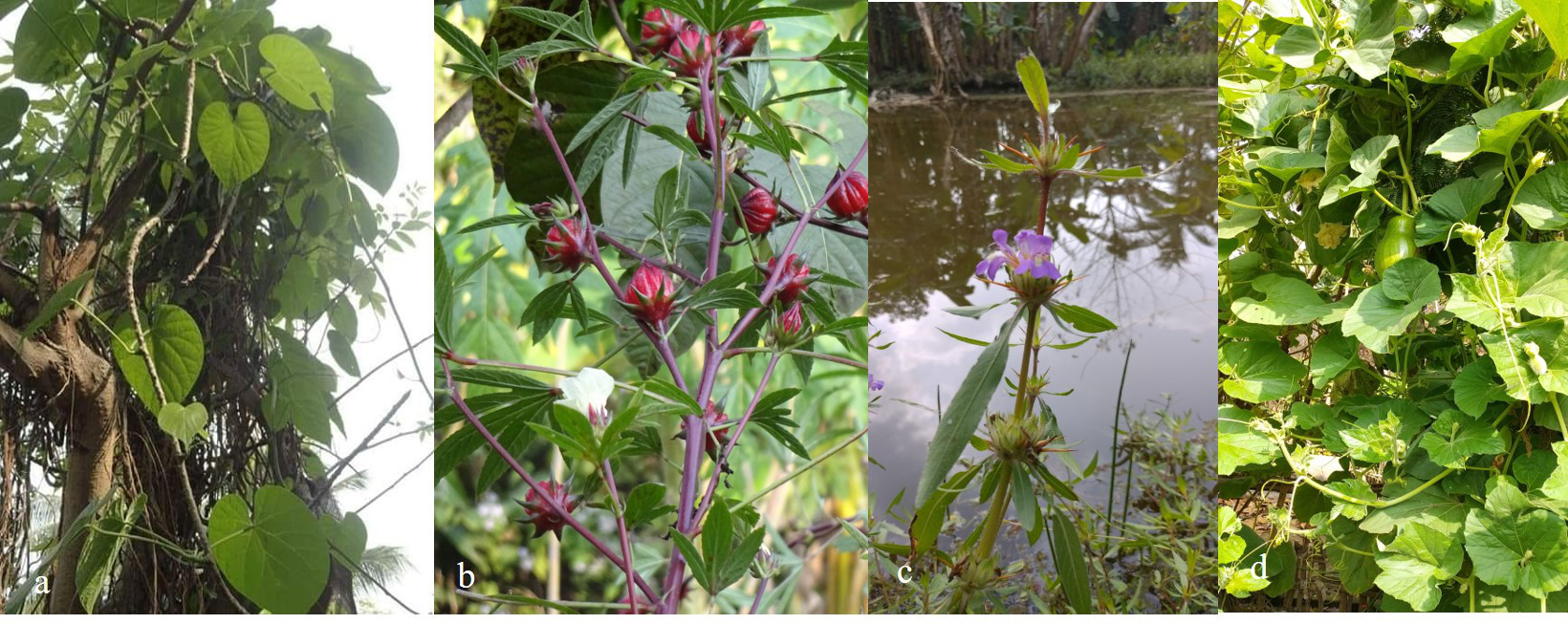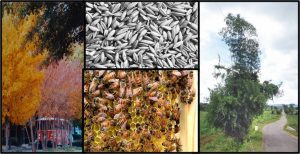Today Radha, Jyotsna, Nandarani, Bimala are very busy. They are going out for a hunt as part of an ancient Bengali ritual, Bhoot Chaturdashi. It involves finding some specific edible greens which will drive the ghosts away. The ritual practices of Indian sub-continent are often underlined with ethnobotanical significance many of which yet remains to be unveiled. Bhoot Choturdoshi, celebrated on the day before Dipanwita Amabasya/Kali Puja can be addressed as Bengal’s own version of Halloween as bhoot literally translates to spirit! And just like any other Bengali ritual, it is connected to special food – leafy greens in this case. This ritual food famously called ‘Choddo Shaak’/‘Fourteen Greens’. It traditionally involved the collection of fourteen uncultivated greens by women from their homestead gardens or home surrounding areas like roadsides, ditches, ponds or canal banks, field bunds. Uncultivated meant those plants which are not purposefully cultivated in fields but grown on their own. While agriculture entailing domestication of several plants secured food and nutrition security it has overlooked many. Yet it is a common traditional knowledge that many un-cultivated greens, fruits and vegetables have been part of the rural lifestyle for ages. Choddo shaak is thus a ritual of celebrating such uncultivated greens. It ensures that while focusing on agricultural fields on a few types of crops the enormous variety of uncultivated foods in our surroundings is not lost or loses importance.
The historical origin of Choddo Shaak ritual – Role of Bengal
Though the word shaak currently implies leafy greens in modern Bengali language (later denoted as B.), the word shaak was traditionally used in Ayurveda to denote six different types of greens. The verse explaining this is:
“Patrang pushpong folong nalong kondong songswedjong totha.
Sakong shorobidhmuddishtong gurung bidyad jothottorom.”

These are leafy greens e.g. spinach, floral greens e.g. Banana flower/B. Mocha, fruit greens e.g. Bottle gourd/B. Lau, tuber greens like Taro/B. Kochu, shoot greens e.g. shoot of Elephant Foot yam/B. Olkochu, mushrooms e.g. Termitomyces heimii/B. Durga Chatu (Bhattacharya 1989, pp.1-5). In 6/24/4 sūkta of Rigveda, a place called Shaakdwip, located in eastern India is mentioned where several Aryans lived. Here ‘Shaakal’ otherwise known as ‘Baskal’ branch of Rig Veda originated. They use to rely on mostly greens instead of meat. These group of people later spread to other regions and came to be known as ‘Shaakdwipi Brahmins’ due to their food habit. It is mentioned in the 13th verse of chapter 84 of ‘Banaparba’ of Mahabharata that Yudhisthira has visited ‘Shakambhar Tirtha’. It is a place in Shaakdwip where Shakhambhari Debi, a deity who eat Shaak was worshipped by serving Debi Shaak for fourteen days’ time period (Sanskrit Choturdosh). It is also mentioned eating of only Shaak for a month-long vrata is comparable to the virtues gained through Asmawamedha Yagna.
“Jodi totro bosenmasong sakaharo noradhip.
Sonunong lovote punyong bajimedh folong totha’’
Thus it is opined that the practice of eating greens to celebrate Shaak Choturdoshi Vrata was started by ‘Baskal’ or ‘Shaakdwipi Brahmins’ (Bhattacharya 1989, pp.1-5). However, there was no mention regarding the period when this particular practice should be done. Krityatatta (16th century C.E.) written by Raghunandan first mentions about the ritual of eating Choddo Shaak on Bhoot Chaturdashi (Bhattacharya 1989, pp.1-5). The verse is:
‘‘Olong kemukbastukong, sarshopong nimbong joyang.
Shalinching hilmochikancho potukong shelukong guruchintotha.
Vontaking sunishonnokong shibdine khadonti je manobah,
Pretottong no cho janti kartikdine krishne cho vute tithou.’’
The fourteen greens consumed during Bhoot Choturdoshi are given in the following table:
| Common English name / Bengali name | Scientific name | Family |
| Elephant foot yam/B. Olkochu | Amorphophallus campanulatus | Araceae |
| Crepe ginger/B. Keu | Cheilocostus speciosus | Costaceae |
| Lamb’s quarters/B. Betho, Bethua shaak | Chenopodium album | Chenopodiaceae |
| Coffee senna/B. Kalkasunda | Senna occidentalis | Fabaceae |
| Mustard/ B. Shorshe | Brassica rapa | Brassicaceae |
| Neem/ B. Neem | Azadirachta indica | Meliaceae |
| Egyptian river hemp/ B. Jayanti | Sesbania sesbans | Fabaceae |
| Sessile joyweed/B. Shalincha, Shanche | Alternanthera sessilis | Amaranthaceae |
| Heart-leaved moonseed/ B. Guruchi, Gulancha | Tinospora cordifolia | Menispermaceae |
| Pointed gourd/B. Palta, Patal shaak | Trichosanthes dioica | Cucurbitaceae |
| Indian cherry/B. Sheluka | Cordia dichotoma | Boraginaceae |
| Watercress/B. Helencha, Hinche shaak | Enhydra fluctuans | Asteraceae |
| Flaming glorybower/ B. Bhant, Bhantaki, Ghentu | Clerodendrum splendens | Lamiaceae |
| Four-leaf clover/ B. Sunishnnok, Sushni shaak | Marsellia quadrifolia | Marsiliaceae |
Even today this ritual is performed by Bengalis of both West Bengal, India and Bangladesh with equal vivacity. Another ritual of Bengal which involves consumption of leafy greens is observed in Manbhum area. This ritual involves cooking 21 types of shaak during Jihur day (Ashwin Sankranti). These include green leaves of Crepe ginger/B. Keu, Lamb’s quarters/B. Bethua, Mustard/B. Shorshe, Coffee senna/B. Kalkasunda, Neem, Egyptian river hemp/B. Jayanti, Sessile joyweed/B. Shalincha, Watercress/B. Helencha, Pointed gourd/B. Palta, Dill/B. Shulfa (Anethum sowa), Heart-leaved moonseed/B. Gulancha, flaming glorybower/B. Ghentu, Four leaf clover/B. Sushni, Water spinach/B. Kalmi, Roselle/B. Tok Bhendi (Hibiscus sabdariffa), Marsh barbel/B.Kulekhara, Asiatic pennywort/B. Thankuni, Water hyssop/B. Brahmi, Adhatoda/B. Vasaka, Felworts/B. Chirota (Swertia chirayita) and green stems of Ele-phant foot yam/ B. Olkochu.
Yampukur vrata, a ritual celebrated by Bengali unmarried girls throughout Bengali Kartik month (mid-October-mid November) diminish the fear of facing hell. It involves making of a small square-shaped model of a pond. The bunds of the pond are planted with Kochu, Turmeric, Kalmi, Sushni, and Hinche, along with rice seedlings are planted in the middle (Basak 1998). The verse said while watering the pond is:
‘‘Sushni-Kalmi lo lo kore
Rajar beta pakkhi mare…
Kalo kochu, sada kochu lo lo kore,
Rajar beta pakkhi mare.”
Greens in scriptures
The practice of eating leafy greens can be traced in scriptures as old as Charaka Samhita (c. 700 B.C.E.)
‘‘Barshashitochitangonang sahasoibark rashmiviih.
Taptanamachitang pidong prayoh saradi kupati.’’
meaning ‘‘in rainy season our body becomes numb/cold. With the advent of autumn, our body becomes suddenly warm by sunlight and often suffers sudden bile upsurge. So sages have alerted us to consume greens in this season to be safe’’ (Bhttacharya 1989, pp.1-5). In Markandaye Purana (7th century C.E.) we get the eulogy of Shakambhari Durga. It denotes that Debi is creating greens, tubers and fruits from her body to save and feed the world from famine. Thus the concept of nutrition garden is not only a need for Indians but also a part of their religion and culture. Mention about consumptions of uncultivated greens is also available in Prakrita Paingal (9th-14th century C.E.), written in Apabhramsa language mentions (Roy 1959, pp. 444). The verse is:
‘‘Oggor votta romvo potta gaiko ghitta dugdh sangyukta.
Moili maccha nalita gaccha dijjai kanta kha punbanta.’’
which means the one who is served by a woman to eat warm rice with gawa ghee (ghee made from cow milk) along with milk, mourola fish (Amblypharyngodon mola) and nolche shaak on banana leaf is lucky.

Kavikankan Mukundaram Chakraborty had written in Chandimangal Kabya (16th century C.E.) about cooking several types of greens in ‘Nidayar Sadhvokhhon’ part. The verse is:
“Amar sadher shima
Helanchi kalmi gima
Boali kutia koro pak.
Ghono kati khor jale
Santlibe kotu tele
Dibe tate paltar shaak.
Pui-doga mukhi-kochu
Tahe fulbori kichu
Ar dibe maricher jhaal.”
It means a person wishes to enjoy helencha, kalmi and gima shaak along with thick gravy of the Bengal boal fish (Wallago attu). Along with it bitter tasting palta shaak, pui shaak stems, mukhi kochu, bori (dried lentil dumpling, a traditional Bengali delicacy) and marich (either black pepper, Piper nigrum or chilli, Capsicum annuum which was brought to India around 16th century C.E. by Portugese) should be well-sauted on fire. The six greens mentioned here are Watercress/B. Helencha or Helanchi or Hinche, Water spinach/B. Kalmi shaak, Bitter Cumin/B. Gima shaak, Pointed gourd/B. Palta shaak, Malabar Spinach/B. Pui shaak (Basella alba), Taro/B. Mukhi-kochu some of which are uncultivated. Another verse in ‘Nidayar moner Kotha’ part also depicts cuisines of greens:
‘‘Bathua thonthon teler pak
Dogi dogi lau cholar shaak’’
Here the greens mentioned are Lamb’s quarters/B. Betho, Bethua shaak, calabash/ B. Lau shaak (Lagenaria siceraria), chickpea/B. Cholar shaak (Cicer arietinum). Thus it is evident that the practice of consuming green with rice is a part of Bengali cuisine culture since long.
Mentions of greens as foods of Bengalis can be also traced in different Vaishnava literatures of 16th century C.E. Chaitanyadeva, the great Bengali saint, himself was fond of eating greens. Bangaleer Itihas (1959) written by Niharranjan Roy also testifies that leafy greens formed a significant part of cuisines of Bengal’s people. It is also very common among Bengalis of Bangladesh. Many of these greens are collected as uncultivated food mainly by the female members of the family in rural Bengal. Other uncultivated greens of Bengal not mentioned in Krityatatta but commonly popular as consumable greens are:
| 1. Amrul (Oxalis corniculata)
2. Kalmi (Ipomoea aquatica) 3. Kulekhara (Hygrophila auriculata) 4. Khrkol/Ghatkol (Typhonium trilobatum) 5.Brahmi (Bacopa monnieri) 6. Dhenki shaak (Diplazium esculentum) 7. Nunia/nun Khuria (Portulaca oleracea) 8. Telakucho (Coccinia grandis) 9. Dandakalash (Leucas aspera) 10. Gima (Glinus oppositifolius) |
11. Thankuni (Centella asiatica)
12. Kantanote/khairakanta (Amaranthus spinosus) 13. Kochu (Colocasia esculenta) 14. Malancha (Alternanthera philoxeroides) 15. Kalmegh (Andrographis paniculata) 16. Vasaka (Justicia adhatoda) 17. Tok bhendi (Hibiscus sabdariffa) 18. Kasturi (Abelmoschus moschatus) 19. Morogful (Celosia argentea var. cristata) |
Significance in current scenario
In the current scenario of climate change imposed agricultural risks when food and nutritional insecurity is held to be directly related to the degradation of public health these ancient rituals should be treated with additional importance. All of these greens are a significant source of several micronutrients. Over-reliance on very few crops has been gradually unleashing the terrors of micronutrient deficiency throughout the world. This consequently is resulting in a different form of hunger called ‘hidden hunger’ which is often ignored or overshadowed by the hunger of energy deficit (Roudart 2002). Global statistics attest to the fact that more than 3.1 million child deaths were attributed to undernutrition (UNICEF 2018a), and that deficiency in iron, zinc, or vitamin A caused an additional 750,000- 850,000 deaths (Food and Agriculture Organization 2004). According to National Family Health Survey (NFHS-4) 2015–2016, 38.4% of Indian children, below the age of 5, were stunted & 35.7% were underweight. The latest Global Nutrition Report showed that 48% of rural Indian women of reproductive age group are anemic (IFPRI 2016), 1/5th of Indian women in the reproductive age group were suffering from chronic energy deficiency while an-other 1/5th were obese (IIPS and ICF 2017).
The ancient rituals discussed is most probably done with intentions to keep the practice of consuming greens both cultivated and uncultivated as all of these fourteen greens mentioned in Krityatatta have some medicinal value which is briefly discussed below (Bhattacharya 1989, pp.1-5).
| Common Bengali Name | Medicinal value |
| Olkochu | Lowers cholesterol, improves cardiovascular health, slow down ageing, anti-diabetes, anti-inflammatory, boosts immunity, slimming food, skin and hair care benefits, cure piles |
| Keu shaak | Beneficial for diarrhoea, cough, jaundice, arthritis, burning sensation, constipation, leprosy, skin diseases, asthma, bronchitis, cures diseases caused by intestinal worms |
| Bethua shaak | Slimming food, also a good source of Vitamin A, B complex and C, and a very good source of dietary fiber, protein, minerals, good for liver |
| Kalkasunda | Diuretic, laxative, blood purifier, antibacterial, and antifungal properties. Also used for treatment of haemorrhoids, gout, rheumatism, cures cough |
| Shorshe shaak | High vitamin K promoting bone health, also a good source of vitamin A, C boosting immunity, slimming food, reduce risk of cardiovascular diseases, eases difficulty passing urine and stool |
| Neem | Detoxifying, good source of calcium and thus promoting bone health, rich in antioxidants and boosts immunity and provide skin and hair care benefits, anti-bacterial, anti-fungal, cures bile derived skin diseases |
| Palta shaak | Rich in vitamin A and C, rich in dietary fibre, boosts immunity and provide skin and hair care benefits, cures biliary disease |
| Jayanti | Used in curing sore throat, hoarseness, cough ailments, chronic coryza, have anti-inflammatory properties, also used as a medicine of scorpion sting, cures wet cough due to season change |
| Shalincha | Cures infertility, prevents cancer, ideal for curing night blindness, reduces body heat, cures piles and irritation during urination |
| Gulancha | Cures gastric problems, diabetes, rheumatoid arthritis (RA), hepatitis, peptic ulcer disease (PUD), gonorrhoea, syphilis, high cholesterol, allergic rhinitis (hay fever), gout, lymphoma and boosts immune system |
| Sheluka | Treating cold, cough, fever and skin diseases, anti-diabetic, appetizer and taste enhancers |
| Hinche | Nutrient-dense food, very high in Vitamin K and also a good source of Vitamin A and C, boosts immunity and provide skin and hair care benefits, high antioxidant, help to prevent diabetes, cancer and heart disease |
| Ghentu | Used in treatment of malaria, coughs, skin diseases, ulcers, rheumatism, asthma, uterine fibroid, gonorrhoea and syphilis, cures diseases caused by intestinal worms |
| Sushni |
It is diuretic, detoxing, anti-inflammatory and hemostatic. Used in the treatment of nephritis, malaria, calms nerve and serves as natural sleep aids |
The consumption of greens will keep the persons healthy, boosts their immune system and will hence keep away the probabilities of ailments. The growing problem of under-nutrition can be only dealt with by addressing compounding factors involving nutrition-sensitive agriculture, increasing incomes, improving food accessibility, shifting dietary patterns, nutrition education and health awareness. Setting up a kitchen garden having these seasonal greens can contribute to this aspect.
It is most plausible that the several illnesses which can be kept at bay by regular consumption of greens are considered as ghosts in these rituals (Singh et al. 2017). The period of celebrating Bhoot Choturdoshi in the month “Kartik” (Bengali pre-winter month) ritual coincides with season change from autumn to winter. This period is accompanied by several diseases like seasonal cough and cold, allergic rhinitis/coryza (inflammation and irritation in the nasal membrane), seasonal skin rashes, gastrointestinal dysfunction and Seasonal Affective Disorder (SAD), type of depression with a seasonal pattern, mostly occurring in the winter and autumn (Singh et al. 2017 and references within). Consumption of the fourteen greens at this time, therefore, aid in retaining our strength and ward off the dangers. This is because as discussed before in details these greens exhibit antihistaminic, antimicrobial, hepatoprotective, antihel-minthic, anti-inflammatory, psychopharmacological, immunomodulatory, anticonvulsant and anxiolytic activity any one of these individually or more (Singh et al. 2017 and references within). Hence it is high time we try to decipher the underlying values of our age-old rituals instead of simply discarding them as mere superstitions.
Acknowledgement
Authors thank Morshed Chayan, Mohad Maruf, from Bangladesh and DRCSC Hingalgunj team for sharing the images.
References:
- Bhattacharya S. 1989. Chiranjib Banousadhi. Vol. I. pp. 1-5. Ananda Publisher.
- Basak S. 1998. Banglar Bratoparbon.
- Roy N. 1959. Bangalir Itihas. pp. 444.
- Roudart L. 2002. L’alimentation dans le monde et les politiques publiques de lutte contre la faim [World food and public policies on hunger relief]. Mondes en de ́veloppement. 30:9–23.
- (2018a). Malnutrition rates remain alarming: stunting is declining too slowly while wasting still impacts the lives of far too many young children. Retrieved from http://data.unicef.org/topic/nutrition/malnutrition/#.
- NFHS-4. 2015-2016. https://pib.gov.in/newsite/mbErel.aspx?relid=169905.
- International Food Policy Research Institute (IFPRI). 2016. https://www.ifpri.org/publication/global-nutrition-report-2016-promise-impact-ending-malnutrition-2030
- IIPS and ICF. 2017. National family health survey, 2015–2016—India, Mumbai: IIPS. http://rchiips.org/NFHS/NFHS-4Reports/India.pdf.
- Singh A, Mondal S, Kundu M.2017. Pharmacology and ethno-pharmacology of traditional Bengali cuisine ‘Choddosak’. International Ayurvedic Medical Journal. 5(10) : 3755-3761.
About Author :
 Debarati Chakraborty1,2,3, Ardhendu Sekhar Chatterjee1, Mahidi Hasan4
Debarati Chakraborty1,2,3, Ardhendu Sekhar Chatterjee1, Mahidi Hasan4
- Development Research Communication and Services Centre (DRCSC), 58A, Dharmatola Road, Kasba, Kolkata- 700042
- Department of Molecular Biology and Biotechnology, University of Kalyani, Kalyani -741235, West Bengal, India
- Centre for Studies in Ethnobiology, Biodiversity and sustainability (CEiBa), Malda, West Bengal, India
- Sonali Bank, Bangladesh
e-mail: debaratichakraborty31@gmail.com,
drcsc.ardhendu@gmail.com



